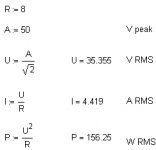traderbam said:Dan,
I see. I misunderstood what you had written.
I think it is best if everyone just drops the mention of "RMS Power" and calls it average power, especially since the evaluation of RMS of power is, as far as I know, of no value whatsoever.
BAM
I guess My explantaion wasn't very clear... ...But...
YAY! YIPEE! YAHOO! (My arms in air yelling with joy )
Finally, someone who understands how silly "RMS Power" really is. Of course, I'm guilty of using the term myself. I usually try to say 100W RMS (and think to my self, power calculated via the RMS method)
And, RMS power is really silly, when you consider that power delivered is always positive. RMS is needed to find the average of a voltage that is negative for any portion of the cycle. But since power is always positive, the average will always be non-zero. i.e. there is no negative power, or rate of doing work. (You'd need negative energy, or negative time... )
-Dan
Now we found the right word.dkemppai said:RMS power is really silly
RMS
Well, I agree insofar as you guys have (implicitly) been discussing sine waveforms. But once you get to waveforms with high crest factor, like a 1 sec puls every forthnight, the RMS is a good way to express the power represented. Average would be less usefull here. It all boils down to using the right tool for the job.
Jan Didden
Well, I agree insofar as you guys have (implicitly) been discussing sine waveforms. But once you get to waveforms with high crest factor, like a 1 sec puls every forthnight, the RMS is a good way to express the power represented. Average would be less usefull here. It all boils down to using the right tool for the job.
Jan Didden
"RMS power" as is being defined here as the RMS of the "power waveform" may be an interesting mathematical exercise but it has little physical meaning. Average power does have physical meaning - since energy delivered is the time integral of power, then the energy delivered (and therefore dissipated as heat) is the average power times time.
"RMS voltage" and "RMS current" are useful for two reasons: (1) "average voltage" for an AC signal is by definition zero, and is therefore useless; (2) "RMS voltage" can be used to calulate "average power" directly via P = V^2/R assuming a resistive load (likewise "RMS current" can be used directly via P = I^2 R).
"Crest factor" is defined as the ratio of peak to RMS value of a signal (voltage or current). Units are usually dB:
CF = 20log(Vpeak/Vrms) = 20log(Vpeak) - 20log(Vrms)
Note that for resistive loads the crest factor (in dB) also give the ratio of peak to average power:
CF = 10log(Ppeak/Pav) = 10log((Vpeak^2/R)/(Vrms^2/R))
= 10log((Vpeak^2)/(Vrms^2))
= 20log(Vpeak/Vrms)
The common definition of "RMS power" seems to be the average power delivered when the output signal is a full-scale sine wave. Since the crest factor of a sine wave is 3dB, the peak power is 3dB higher than the "RMS power".
Conclusion: "RMS power" is a misnomer. Strictly interpreted as the mathmatical RMS of the instantaneous power waveform it has no useful physical meaning. As commonly used it is fairly useful as long as it is consistantly interpreted. I guess "RMS power" is better from a marketing perspective than "average power for a full-scale sinusoidal output".
"RMS voltage" and "RMS current" are useful for two reasons: (1) "average voltage" for an AC signal is by definition zero, and is therefore useless; (2) "RMS voltage" can be used to calulate "average power" directly via P = V^2/R assuming a resistive load (likewise "RMS current" can be used directly via P = I^2 R).
"Crest factor" is defined as the ratio of peak to RMS value of a signal (voltage or current). Units are usually dB:
CF = 20log(Vpeak/Vrms) = 20log(Vpeak) - 20log(Vrms)
Note that for resistive loads the crest factor (in dB) also give the ratio of peak to average power:
CF = 10log(Ppeak/Pav) = 10log((Vpeak^2/R)/(Vrms^2/R))
= 10log((Vpeak^2)/(Vrms^2))
= 20log(Vpeak/Vrms)
The common definition of "RMS power" seems to be the average power delivered when the output signal is a full-scale sine wave. Since the crest factor of a sine wave is 3dB, the peak power is 3dB higher than the "RMS power".
Conclusion: "RMS power" is a misnomer. Strictly interpreted as the mathmatical RMS of the instantaneous power waveform it has no useful physical meaning. As commonly used it is fairly useful as long as it is consistantly interpreted. I guess "RMS power" is better from a marketing perspective than "average power for a full-scale sinusoidal output".
RMS power and peak power
I look at it like this
RMS power is nice when you want to know what size PSU is in an amp
PEAK power dosen't tell you the rating of the PSU, but it can be used to figure out the max NO load voltage sving of the amp.
I general people often put what ever wattage is greater on the AMP. Just take the PMPO standard. That is totally silly i think.
\Jens
I look at it like this
RMS power is nice when you want to know what size PSU is in an amp
PEAK power dosen't tell you the rating of the PSU, but it can be used to figure out the max NO load voltage sving of the amp.
I general people often put what ever wattage is greater on the AMP. Just take the PMPO standard. That is totally silly i think.
\Jens
- Status
- This old topic is closed. If you want to reopen this topic, contact a moderator using the "Report Post" button.
- Home
- Amplifiers
- Solid State
- Calculation of RMS power output?

